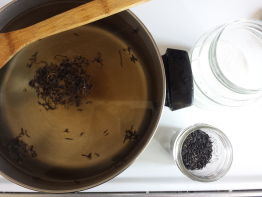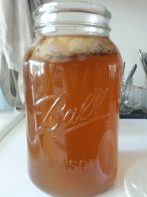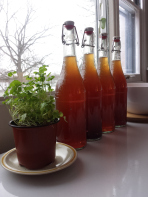The most popular question we get up at the Co-op Corner is what is kombucha?
Well, kombucha is a fermented tea that can be flavored with a variety of fruits and spices. It's low in sugar and caffeine, high in probiotics, and can easily be made and continuously brewed at home.
Tea + Water + Sugar + Scoby = Kombucha
Wait. What's a scoby? Honestly, it's a bit disgusting to look at, but a scoby (symbiotic colony of bacteria and yeast) is a culture that will transform your sugary tea into something tangy and effervescent.
We get our kombucha from Bloom Ferments, a company in Grand Rapids, and sell it on tap at the Kalamazoo Farmers Market and PFC Natural Grocery and Deli. It's an amazing and refreshing drink on a hot market day, but if you've become addicted like me you might want to give making it on your own a try. If not, bring your own cup to the Co-op Corner and we'll give you $.50 off!
How to brew kombucha:
Equipment:
4 quart stock pot
1 gallon jar
1 thin cloth and rubber band
1 mesh strainer, or tea ball
4, 750 ml swing top bottles (or similar)
Ingredients:
2 tablespoons loose leaf tea
*alternatively, 8 tea bags, but lets keep this waste free
1 cup white sugar
14 cups water
2 cups unpasteurized, plain kombucha
1 scoby
*buy one online, make your own, or find a friend with one
Fruits and herbs (for flavoring)
Directions:
- Make the tea: Boil the water and sugar in the stock pot until it is dissolved. Brew the tea and let sit until the water comes to room temperature. I usually do this at night and let it sit tight with a towel on top until morning. This will also help some of the chlorine in your tap water to dissipate.
- Add starter kombucha: Remove the tea leaves and pour tea into a 1 gallon jar. Add in 2 cups of store bought kombucha, which will will help kick start the solution and keep unwanted bacteria from forming.
- Add the scoby: Gently place the scoby on top of the water. It may float or sink, but either way it's doing its job. Cover the jar with a cloth and rubber band. This ensures that fruit flies or other things don't end up in the mixture.
- Ferment for one week: Let the tea sit and ferment for 7-10 days in a dark place. I keep mine in a cabinet in the kitchen. At seven days test it. It is done whenever it tastes pleasantly sweet and tart, and the longer it sits, the more vinegary it will taste.
- Bottle kombucha: Remove the scoby and 2 cups of finished kombucha. Bottle the rest of the tea into air tight containers. I use swing top bottles that my grandpa saved for me, and a siphon hose that I have from other brewing projects. I find that this works well for me, but a funnel and other reused jars will work fine too.
- Flavor: If you want to flavor your kombucha, add any juice, fruit (try pureeing them first), or herbs directly into your bottles with the tea. Alternatively, you may infuse the flavorings in a covered jar (without the scoby) for a day before straining and bottling for secondary fermentation. Of course we recommend using what's in season at the market! Strawberries in May, peaches in July, apples in September...
- Secondary Fermentation: Let the bottles sit in a dark place for 1-3 days. I leave mine under the sink. While the kombucha is already carbonated, this step will help it become even more bubbly. Pay close attention to this, as there is a slight risk of a bottle building up too much pressure and exploding. If your house if warm it will carbonate faster, and if it is cold it will carbonate slower. You'll get the feel for it after a few ferments. When you think it is sufficiently carbonated, place the bottles in the fridge where the cold will stop the fermentation.
- Make your second batch: Prepare another batch of tea, and place the scoby and two cups of your fresh, plain kombucha in the gallon jar. Start the 7-10 day fermentation process again.
Notes:
Tea: You can use any tea (black, white, green, oolong), so long as it does not contain oils. Check the ingredients and opt for one with only tea leaves- no natural flavors- which could contain oils.
Sugar: Some people have concerns about white sugar, but you must use sugar, no substitutes. It will feed the scoby, and the finished product will not contain much sugar in the end.
Metal: Try to avoid prolonged contact with metal. It will eventually weaken the scoby.
Pausing your brew: If you're going to be gone for a few weeks or want a break, you can always make a batch and let it sit. The brew will become too vinegary to drink, but the scoby will be fine. If you will be gone longer than a few weeks, you can place the scoby in a few cups of kombucha in the fridge. After one month, place the scoby in a fresh jar of kombucha.
Scoby: If your scoby turns black or forms mold, throw it out and start again. The brown stringy bits that form under the scoby are fine, as it is apart of the process. The scoby will grow, so every once in a while peel off the bottom layers and throw them in the compost or give them to a friend.





